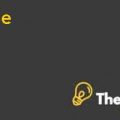Tyson Food Inc Case Study Analysis
Liquidity Ratio:
Liquidity ratios shows that company’s ability to meet the short term obligations of the company. Whenthe company is unable to meet its financial obligations then the company is considered to be illiquid, which leads the company towards cash crunches and other distress. It is an ability of the company to pay its obligation when it is due. The liquidity ratios are shown in times.The ratios that are calculated under the head of liquidity ratio are:
Current Ratio:
Current ratio shows the organization’s capacity to pay its transient commitments or current obligation. The current ratio vary from industry to industry.The current ratio of Tyson food Inc. is 1.3 times, which shows that the organization has enough money to pay its momentary risk.Due to high liquid assets; the company would not face difficulty in paying its short term debt or would not require any funding to pay its debt. The higher current ratio also shows that the company has excessive cash so it should utilize it in generating profit.
Quick Ratio:
Quick ratio of the company further describes the company’s ability to pay off its current liability, after deducting some components that are less liquid. The quick ratio of the company is 0.55 times, which indicates that the company has .55 cent current assets against the 1 dollar liability, and it is concluded that the company is average liquid.
Solvency Ratio:
Solvency ratio is defined as the company’s ability to pay off its total debt. If the company is unable to pay its debt then it is considered to be insolvent, which leads the company towards bankruptcy. The lower solvency ratios are preferable and it is assumed that the company is financially secure.
Debt to Assets Ratio:
Debt to asset ratio shows the leverage of the company, and it also shows that how many assets are financed by the debt. The debt to assets ratio of the company is 57%, which indicates that the company is highly leveraged.
Debt to Equity Ratio:
Debt to equity ratios shows that how much higher the debt is as compared to the equity. The debt to equity ratio of the company is 1.33 time, which indicates that the company is highly reliant on the debt rather than equity participation.
Efficiency Ratio:
It shows that how much efficient the company is in using its resources or managing its daily operations to generate profits. Higher efficiency ratios are preferable. The following are the sub categorization of efficiency ratio:
Asset Turnover Ratio:
It shows that how efficiently the company is using its assets to generate the sales. The assets turnover ratio of the company is 128%, which shows that the company is using its assets efficiently to generate sales.
Account Receivable Turnover:
It shows that how quickly the company is receiving its payments from its customers. The account receivable turnover of Tyson is 21.7, which indicates that the company is using tightening credit policies in order to receive its payments from the customers.
Conclusion
All the ratios vary from industry to industry and it is assume that the company should meet the average of the industry. It is concluded that the overall profitability ratio of the company is lower. Due to high expenses all the profit margin of the company are lower and the portion of expenses are higher than the profit in sales. The liquidity ratio of the company is considered to be enough to pay its short term debt. However, the company has high amount of inventory in its current assets. The solvency ratio of the company is quiet higher, which shows that the company is highly dependent on the debt, which would create difficulty in future borrowing. The efficiency ratio of the company seems to be higher, which shows that the company is managing its daily operations and utilizing its resources very efficiently.....................................
This is just a sample partical work. Please place the order on the website to get your own originally done case solution.










